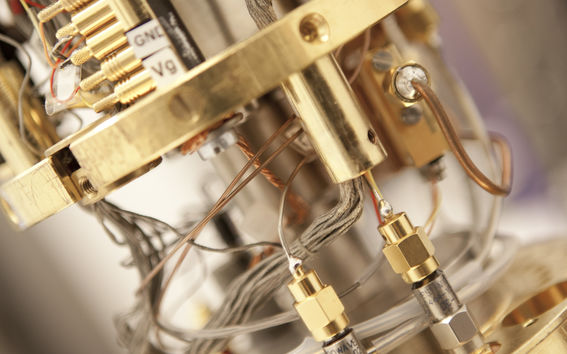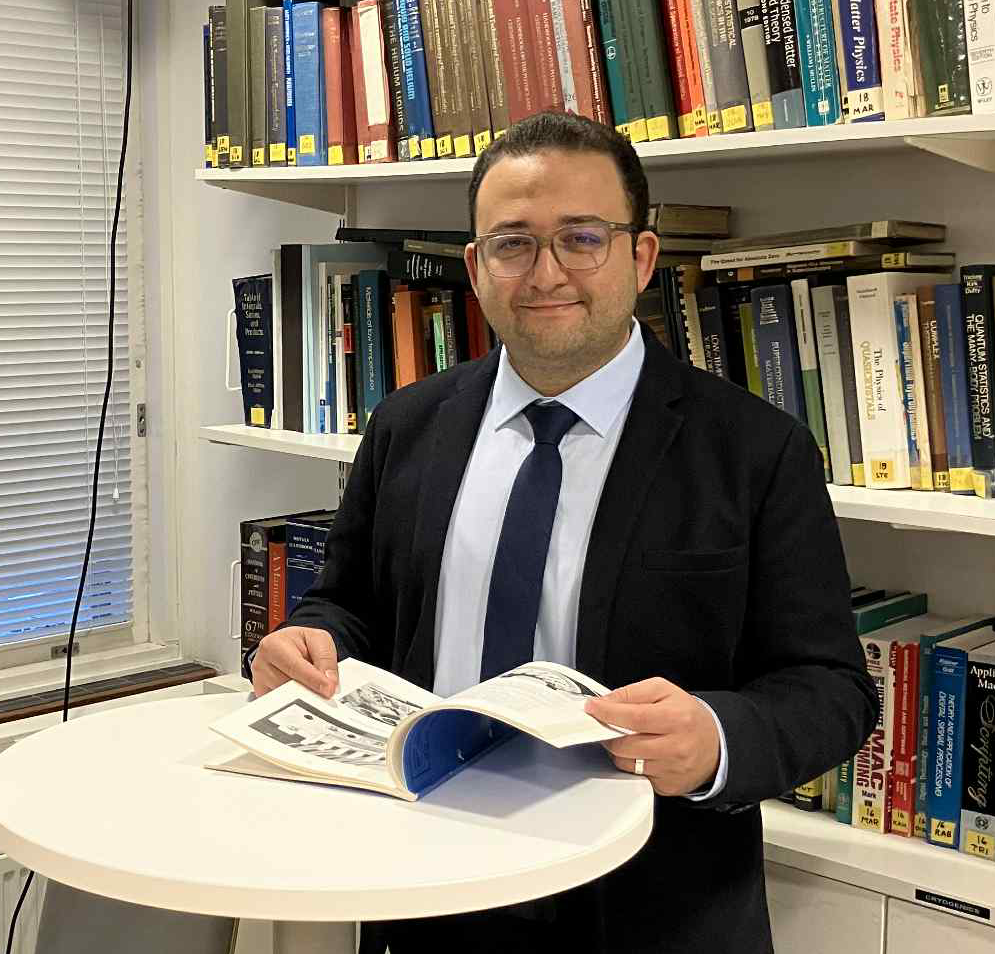Quantum Circuits and Correlations (NANO)

Group leader
Professor Pertti Hakonen
We are working on superconducting quantum technology, using both regular Josephson junctions as well as hybrid devices based on 2d materials. Among others, recently, we have developed efficient, broad band entanglement generators for microwave frequencies, nearly quantum limited parametric amplifiers, correlation-preserving splitters for Cooper pairs, and high-resolution force sensors for detection of emergent quasiparticles in topological systems. We have also interest in creating non-Abelian quasiparticles which form the basis for topological quantum computation.
Mesoscopic Josephson junctions: quantum amplifiers and entanglement
Mesoscopic Josephson junctions provide a unique opportunity to construct ultra sensitive quantum detectors and Josephson parametric amplifiers (JPA). These devices are important when performing single-shot read-out of quantum bits (qubits) or making quantum measurements in the style of quantum optics. We have recently demonstrated two-mode squeezing of microwaves over a band of 4 GHz using a traveling wave parametric amplifier, TWPA (with logarithmic negativity around 0.8). Even larger two-mode squeezing has been reached in l/4 parametric resonators at 6 GHz. Using modern digital technologies in conjunction with our TWPAs, we can track many frequencies coherently and test methods for continuous variable quantum information processing.
Besides pairwise entanglement, we are working on genuine multifrequency entanglement, which we have demonstrated experimentally up to four microwave modes. Our work has also verified that the entangled state depends on relative phases of the pumps, by optimization of which square cluster states can be reached. Such states have been proven to form a platform for universal continuous variable quantum computation. Apart from such one-way quantum computation schemes, possible applications include n-node distributed quantum sensor networks, in which quantum advantage due to entanglement yields a √n improvement in measurement accuracy.
In hybrid superconucting systems, we have worked actively on Cooper pair splitting. Patterned quantum dots in graphene were employed as a means to split Cooper pairs and reach high levels of crossed Andreev reflection. Dictinct from regular electromotive biasing, we have demonstrated the possibility of splitting driven by thermal gradient. Further work is ongoing to transfer the entanglement to photons at telecommunication wavelengths.
2D materials
In addition to semimetallic graphene, there are many atomically thin 2D materials which can be stacked together to make heterostructures with novel functionalities. Transition metal dichalcogenides have energy gaps in the range of one electron Volt, which makes them suitable for light emitting diodes. Our interest in these structures arises from the possibility of reaching a large flux of entangled photons. Such photon sources would provide schemes for quantum secure telecommunications as well as a means to realize distributed quantum computation. Our heterostructures are made within a controlled atmosphere, which enhances the variety of available layers and allows the use of reactive materials, for instance superconducting NbSe2.
In addition to superconductor-graphene-superconductor hybrids, we have employed monolayer graphene as a platform for high-sensitivity electrical investigations of fundamental 2D phenomena. Our experiments made on freely suspended membrane have yielded new information on the origin of 1/f noise in metallic conductors which is still an open problem. We find clear evidence on the role of diffusion and clustering of impurities in the formation of 1/f noise.
Topological properties of fractional particles
The quantum topology of Fractional Quantum Hall matter manifests itself in unusual quasiparticle exchange statistics, with neither Fermionic nor Bosonic character. Such exotic particles are called anyons, either Abelian or non-Abelian. The wave function of Abelian anyons may acquire an arbitrary phase after moving one particle around an another one on the plane. Even more remarkable, the exchange of non-Abelian anyons will not just alter the phase of their wave functions but change the ground state of the whole system as well. This unique property of non-Abelian anyons may offer a possible route for designing quantum devices with topological protection against decoherence. Altogether, this work on fundamental aspects of anyonic quantum technologies will pave the way towards future realization of non-Abelian quantum computation.
Force sensing based on mechanical resonances
Mechanical resonances both in carbon nanotubes and graphene can be employed for sensing of small forces acting on the resonator. We have demonstrated charge sensing at record high resolution in mechanically driven CNTs, while in grapehene, we have employed force sensing in determining the de Haas - van Alphen effect in 2D materials, i.e. sensing of magnetization.
Collaboration
We have active research collaboration with the following research groups:
- Nems, Kvantti, Pico, and NANO-theory groups of Low Temperature Laboratory
- Department of Applied Physics Peter Liljeroth, Aalto University
- Laboratoire Pierre Aigrain, ENS Bernard Placais, Laboratoire Pierre Aigrain, Ecole Normale Supérieure, Paris, France
- Cornell University Jeevak Parpia, LASSP, Ithaca, USA
- Landau Institute Yuriy Makhlin, Landau Institute, Moscow, Russia
- Geneva Univeristy Alberto Morpurgo, Geneva University, Switzerland
- Karlsruhe Institute of Technology Romain Danneau, Karlsruhe Institute of Technology, Germany
- Hebrew University of Jerusalem Edouard Sonin, Racah Institute of Physics, Jerusalem, Israel
- University of Oulu Erkki Thuneberg, University of Oulu, Oulu, Finland
- Department of Condensed Matter Physics Tomas Novotny, Charles University, Prague, Czech Republic
- Quantronics group of Technical Research Centre of Finland Heikki Seppä, VTT, Espoo, Finland
- Quantum Triangle collaboration Antti Manninen, MIKES, Espoo, Finland
- RODIN project partners EU STREP for patterning suspended graphene, 2010 - 2013
- ENTS project partners ESF EUROgraphene project for entangled spin pairs, 2010 - 2013
Facilities
Dry pulse-tube based dilution refrigerators
Two dry pulse-tube based dilution refrigerators: One BlueFors BF-LD250 cryostats, one BF-SD250. Cryostats are configured so that they can be employed from simple DC electrical measurements to involved microwave measurements for noise, cross-correlations, and vibrations in NEMS resonators. One cryostat is equipped with 9T superconducting magnet. Specifications: - Base temperature: 8-10 mK, - Cooling power mixing chamber @ 100 mK: 250 uW, - Cool-down time to base temperature SD: 18 hrs, - Cool-down time to base temperature LD 24 hrs, - Mixing chamber diameter: SD Series 150mm LD Series 290mm.
Dry nuclear demagnetization cryostat
Based on BlueFors model BF-LD400 dilution refrigerator with 9T superconducting magnet. Characteristics of dilution unit: - Base temperature: 7 mK, - Cooling power mixing chamber @ 100 mK: 550 μW. The experimental cell for liquid 3He (0.6 mol) is embedded inside the top part of the nuclear demagnetization stage. The refrigerator cools 3He in the experimental cell down to 160 μK.
Plastic Dilution Refrigerator (PDR)
One small 3He/4He dilution refrigerator down to 30-50 mK with approximately 4-hour cool down time. These plastic dilution refrigerators, which are built in-house, provide us with fast cool down times and thus high throughput in sample characterization.
Room temperature measurement and characterization equipment
A wide range of equipment for sample characterisation, including Micro-Raman, scanning electron microscope, atomic force microscope, RF testing equipment, etc.
Nano- and Micro-fabrication facilities
The following facilities are available in the Low Temperature Labs semi-clean room: electron beam lithography, field emission electron microscope JEOL7100F, DCA UHV e-beam evaporator system with sample stage having angle control and rotation, film deposition system, reactive ion etching, critical point dryer, etc.
Latest publications
Steady-state dynamics and nonlocal correlations in thermoelectric Cooper pair splitters
Microwave dynamics of gated Al/InAs superconducting nanowires
Continuous time crystal coupled to a mechanical mode as a cavity-optomechanics-like platform
Multimode Operation of a Superconducting Nanowire Switch in the Nanosecond Regime
Observing the Poisson distribution of a coherent microwave field with a parametric photon detector
Low-noise microwave parametric amplifier based on self-heated nonlinear impedance with subnanosecond thermal response
Superconductivity from incoherent Cooper pairs in the strong-coupling regime
From Bulk Molybdenum Disulfide (MoS2) to Suspensions of Exfoliated MoS2 in an Aqueous Medium and Their Applications
Electronic noise - From advanced materials to quantum technologies
Special Issue : Electronic Noise - From Advanced Materials to Quantum Technologies
Research group members








